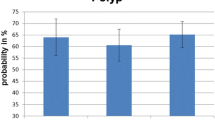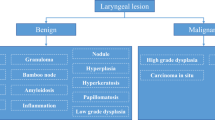Abstract
No clinical standard procedure has yet been defined to quantify the vascular pattern of vocal folds. Subjective classification trials have shown a lot of promise. Narrow band imaging (NBI) as an endoscopic imaging tool is useful, because it shows the vascular structure clearer than white light endoscopy (WL) alone. Endoscopic images of 74 human vocal folds (NBI and WL) were semi-automatically evaluated after image processing with respect to pixels of vessels and mucosa by the software MeVisLab. The ratios of vessel/mucosa pixels were compared. Using NBI, more vocal fold vessels are visible compared with WL alone (p = 0.000). There may be a difference between the right and left vocal folds due to the handedness of the examiner (p = 0.033) without any interaction between the method (NBI/WL) and the side (right/left) (p = 0.467). MeVisLab is a suitable tool for the objective quantification of the vessel/mucosa ratio for NBI and WL endoscopic images. NBI is an appropriate endoscopic tool for examination of diseases of vocal folds with changes in the vascular pattern. There is evidence that the handedness of the examiner may have an influence on the quality of the examination between the right and left vocal folds.





Similar content being viewed by others
References
Folkman J, Watson K, Ingber D, Hanahan D (1989) Induction of angiogenesis during the transition from hyperplasia to neoplasia. Nature 339:58–61
Carmeliet P, Jain RK (2000) Angiogenesis in cancer and other diseases. Nature 407:249–257
Hanahan D, Weinberg RA (2011) Hallmarks of cancer: the next generation. Cell 144:646–674
Yamada G, Kitamura Y, Kitada J, Yamada YI, Takahashi M, Fujii M, Takahashi H (2011) Increased microcirculation in subepitheliumial incasion of lung cancer. Intern Med 50:839–843
Arens C, Piazza C, Anrea M et al (2015) Proposal for a descriptive guideline of vascular changes in lesions of the vocal folds by the committee on endoscopic laringea imaging of the European Laryngological Society. Eur Arch Otorhinolaryngol. doi:10.1007/s00405-015-3851-y
Tateya I, Muto M, Morita S et al (2016) Endoscopic laryngo-pharyngeal surgery for superficial laryngo-pharyngeal cancer. Surg Endosc 30:323–329
http://www.olympus.de/medical/de/medical_systems/applications/urology/bladder/narrow_band_imaging__nbi_/narrow_band_imaging__nbi_.html. Accessed 17 December 2015
Mizuno K, Gono K, Takehana S, Nonami T, Nakamura K (2003) Narrow band imaging techniaque. Tech Gastrointest Endosc 5:78–81
Rossol S (2008) Endoscopic staining techniques in transistion—Narrow Band Imaging (NBI) and what else? Olymp Inft 2:4–7
Arens C, Vorwerk U, Just T, Betz CS, Kraft M (2012) Progress of endoscopic diagnosis of dysplasia and carcinoma of the larynx. HNO 60:44–52
Vincent BD, Fraig M, Silverstri GA (2007) A pilot study of narrow-band imaging compared to white light bronchoscopy for evaluation of normal airways and premalignant and malignant airways disease. Chest 131:1794–1799
Shibuya K, Nakajima T, Fujiwara et al (2010) Narrow band imaging with high-resolution bronchovideoscopy: a new approach for visualizing angiogensis in squamous cell carcinoma of the lung. Lung Cancer 69:194–202
Suzuki H, Saito Y, Oda I, Kikuchi T, Kiriyama S, Fukunaga S (2012) Comparison of narrowband Imaging with autofluorescence imaging for endoscopic visualization of superficial squamous cell carcinoma lesions of the esophagus. Diagn Ther Endosc 2012:507597. doi:10.1155/2012/507597
Probst A, Bittinger M, Jechart G, Scheubel R, Arnholdt H, Messmann H (2006) Autofluoreszenzendoscopie (AF) and Narrow Band Imaging (NBI)—is a differentiation of colonic polyps in vivo possible? Z Gastroenterol 44:396
Gi TP, Robin EA, Halmos GB, van Hemel BM, van den Heuvel ER, van der Laan BFAM, Plaat BEC, Dikkers FG (2012) Narrow band imaging is a new technique in visualisation of recurrent respiratory papillomatosis. Laryngoscope 122:1826–1830
Yang H, Zheng Y, Chen Q et al (2012) The diagnostic value of narrow-band imaging for the detection of nasopharyngeal carcinoma. ORL 74:235–239
Kraft M, Fostiropoulos K, Gürtler N, Arnoux A, Davaris N, Arens C (2015) Value of narrow band imaging in the early disgnosis of laryngeal cancer. Head Neck. doi:10.1002/hed.23838
Watanabe A, Tsujie H, Taniguchi M, Hosokawa M, Fujita M, Sasaki S (2006) Laryngoscopic detection of pharyngeal carcinoma in situ with narrowband imaging. Laryngoscope 116:650–654
Voigt-Zimmermann Arens C (2014) Vascular lesions of vocal folds—part 1: horizontal vascular lesions. Laryngo-Rhino-Otol 93:819–830
Arens C, Glanz H, Voigt-Zimmerman S (2015) Vascular lesions of vocal folds—part 2: perpendicular vascular lesions. Laryngo-Rhino-Otol 94:738–744
Turkmen HI, Karsligil ME, Kocak I (2012) Assessment of videolaryngostroboscopy images based on visible vessels of vocal folds. Eng Med Biol Soc 2012:6251–6254. doi:10.1109/EMBC.2012.6347423
Mizuno K, Kudo S, Ohtsuka K, Hamatani S, Wada Y, Inoeu H, Aoyagi Y (2010) Narrow-banding images and structures of microvessels of colonc lesions. Dig Dis Sci 56:1811–1817
Kubota M, Murakami T, Nagano H et al (2012) Xenon-inhalation computed tomography for noninvasive quantitative measurement of tissue blood flow in pancreatic tumor. Dig Dis Sci 57:801–805
Bai R, Cheng X, Qu H, Shen B, Han M, Wu Z (2009) Solitary pulmonary nodules: comparison of multi-slice computed tomography perfusion study with vascular endothelial growth factor and microvessel density. Chin Med J 122:541–547
Jiang HJ, Zhang ZR, Shen BZ, Wan Y, Guo H, Li JP (2009) Quantification of angiogenesis by CT perfusion imaging in liver tumor of rabbit. Hepatobiliary Pancreat Dis Int 8:168–173
Fasel JH, Majno PE, Peitgen HO (2010) Liver segments: an anatomical rationale for explaning inconsistencies with Couinaud´s eight-segment concept. Surg Radiol Anat 32:761–765
Wilms GE, Willems E, Demaerel P, De Keyzer F (2012) CT volumentry of lumbar bodies in patients with hypoplasia L5 and bilateral spondylolysis and in normal controls. Neuroradiology 54:839–843
http://www.mevislab.de/. Accessed 07 December 2015
Jähne B (2012) Digital image processing and image acquisition. Springer, Berlin, p 711
Frangi AF, Wiro JN, Koen LV, Max AV (1998) Multiscale vessel enhancement filtering. In: Proceedings of Medical Image Computing and Computer-Assisted Intervention (MICCAI), Springer, Berlin, pp 130–137
Piazza C, Cocco D, De Benedetto L, Del Bon F, Nicolai P, Peretti G (2010) Narrow band imaging and high definition television in the assessment of laryngeal cancer: a prospective study on 279 patients. Eur Arch Otorhinolaryngol 267(3):409–414. doi:10.1007/s00405-009-1121-6
Piazza C, Cocco D, Del Bon F, Mangili S, Nicolai P, Majorana A, Bolzoni Villaret A, Peretti G (2010) Narrow band imaging and high definition television in evaluation of oral and oropharyngeal squamous cell cancer: a propective study. Oral Oncol 46:307–310
Ni XG, He S, Xu ZG et al (2001) Endoscopic diagnosis of laryngeal cancer and precancerous lesions by narrow band imaging. J Laryngol Otol 125:288–296
Schossee A, Voigt-Zimmermann S, Kropf S, Arens C (2015) Evaluation of a classification model of horizontal vascular lesions of the vocal fold. Laryngo-Rhino-Otol: doi:10.1055/s-0035-1559677
De Biase NG, de Lima Pontes PA (2008) Blood vessels of vocal folds. Arch Otolaryngol Head Neck Surg 134:720–724
Zabrodsky M, Lukes P, Lukesova E, Boucek J, Plzak J (2014) The role of narrow band imaging in detection of recurrent laryngeal and hypopharyngeal cancer after curative radiotherapy. BioMed Res Int. doi:10.1155/2014/175398
Staniková L, Kucová H, Walderová R, Zelenik K, Satanková J, Kominek P (2015) Value of narrow band imaging endoscopy in detection of early laryngeal squamous cell carcinoma. Klin Onkol 28:116–120
Wang WH, Tsai KY (2014) Narrow-band imaging of laryngeal images and endoscopically reflux esophagitis. Otolaryngol Head Neck Surg 152:874–880
Author information
Authors and Affiliations
Corresponding author
Ethics declarations
Conflict of interest
All authors declare that no conflict of interest exists.
Ethical approval
All procedures performed in studies involving human participants were in accordance with the ethical standards of the institutional research committee (Project Number: 107/14) and with the 1964 Helsinki declaration and its later amendments or comparable ethical standards.
Informed consent
Informed consent was obtained from all individual participants included in the study.
Rights and permissions
About this article
Cite this article
Pliske, G., Voigt-Zimmermann, S., Glaßer, S. et al. Objective quantification of the vocal fold vascular pattern: comparison of narrow band imaging and white light endoscopy. Eur Arch Otorhinolaryngol 273, 2599–2605 (2016). https://doi.org/10.1007/s00405-016-4071-9
Received:
Accepted:
Published:
Issue Date:
DOI: https://doi.org/10.1007/s00405-016-4071-9




